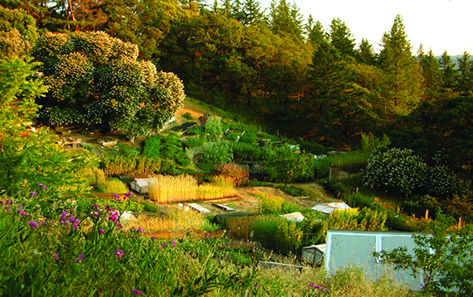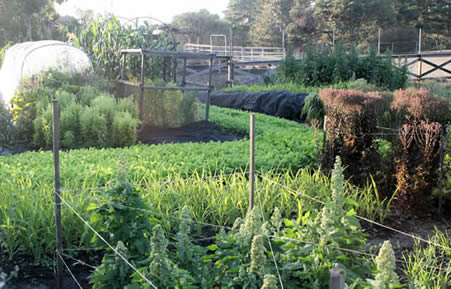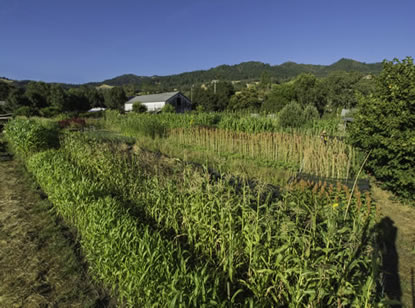2017 Ecology Action Research by Site
By Ecology Action Farm Staff
During 2017, Ecology Action supported four different Mini-Farm projects in northern California, each conducting trials and research appropriate to its climate. Below is some of the research that was conducted, described by staff at each location. With the changes in the organization, Common Ground Garden has been closed, and The Jeavons Center Mini-Farm is being maintained in a fallow year, with the biointensive beds growing compost crops. The area of cultivation at the EA Mini-Farm at Golden Rule has been reduced from approximately 100 beds to 10, and the Victory Gardens for Peace Mini-Farm has taken on additional projects and programs. For more information on these changes, see Garden Report: Changes At Ecology Action, in this issue.

The Jeavons Center Mini-Farm: Willits, CA.
Mountainous, formerly poor soil, vastly improved using GB.
Jes Pearce, former Mini-Farm Manager
The Eight-Bed-Unit Diet Design and a 20-Bed-Unit Diet Design are being grown to produce one person's calories and compost in the smallest area.
40 different varieties of dahlias are being grown to explore the economic potential of selling cut flowers and tubers for propagation.
Variety trials are underway trying to get the fastest dry beans, compare flour corns versus flint corns and grow the tallest amaranth possible.
Exploring different intercropping combinations to maximize production. These include amaranth and New Zealand spinach, quinoa and lettuce, beans and corn, squash and corn, sunflowers and gourds, cucumbers and summer squash, and quinoa with wooly pod vetch.
We are living our research as we strive to grow, harvest, clean, cook, and eat the food grown here in a delicious and ecological way. We are always experimenting in the kitchen, which is so important when growing your own food.

Victory Gardens for Peace Mini-Farm: Mendocino, CA.
Northern California coastal environment.
Matt Drewno, Mini-Farm Manager,
In 2016 a diet design in less than 1000 sq ft was completed, which may be the smallest human diet footprint in human history. Currently, two are being grown in different sections of the garden. A design that might be more realistically grown in 1600 sq ft is being considered.
Conducting spacing trials on basil, quinoa, leeks, kale and others in the clay section of the garden; spacing can be slightly closer perhaps due to the clay and increased cation exchange capacity.
Growing out several key varieties for the VGfP Seed Bank with a focus on crops favorable to the maritime climate. This also includes the biomass values for total carbon production and built-cured compost.
Research continues on salinity-tolerant species with a focus on barley over other grains, and a move away from beans. Gypsum applied at different times of the year seems to help leach the salts.
Developing a model to train apprentices, which uses 8-bed units instead of 3-bed, to expose them to the importance of diet design and efficient planning.
For more on Matt Drewno and Victory Gardens for Peace's 2018 initiatives in this issue, see: Biointensive Team Corner: Update on Matt Drewno and Garden Report: Changes at Ecology Action.

EA Mini-Farm at Golden Rule: Willits, CA.
Fertile valley land
Rachel Britten, Mini-Farm Manager
Observing preferred planting times to try to maximize the summer season. This year sunflowers were in the ground two weeks earlier than usual (April 15). These survived multiple frosts and grew to over 12 feet tall!
Experimenting with crop varieties, including five different melons bred to mature quickly. Three exciting corn varieties are being tried. This includes a cold tolerant corn. It both grows tall (6–7 ft) and tassels early. Also growing a yellow (and higher-nutrition) version of a favorite variety of the white Hickory King corn.
Trialing direct sowing versus transplanting beans. Transplanting allows the production of extra calories before putting in winter compost crops. However, a lot of transplanting means additional labor at a time when there's a lot of harvesting and weeding to be done. Experimenting to see if transplanting significantly increases the yield to determine if direct sowing might be labor-saving at a time when it is needed.

Common Ground Garden: Palo Alto, CA (closed in 2017).
Urban /suburban environment.
Paul Higgins, former Garden Manager
Two-bed vetch test: Comparing grain and potato yields using different amounts of interplanted vetch, which fixes a large amount of nitrogen in the soil but can choke out crops if interplanted too densely.
Comparing the health of spring wheat between seedlings that are transplanted and seed that is broadcast directly into the bed.
Comparing the number of severely slug-damaged heads of lettuce between pre-broadcasting bok choy seeds into the bed and maintaining bare soil between the plants.
Running a trial to see whether two back-to-back crops of quinoa can be grown in our region, one transplanted in February and the other in June.
Examining whether there is a difference in yield between potatoes planted in hills (raised rows) and planted in level beds.
top | Newsletter Home |Table of Contents| Archive

|






